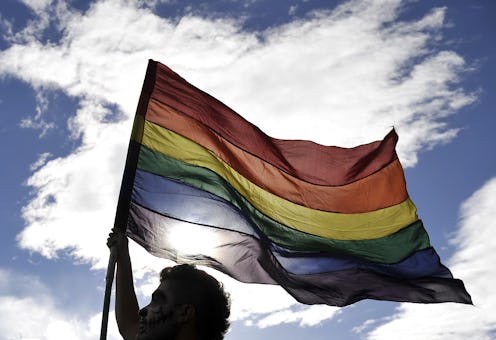With increasing attention brought to transgender people in the media, more and more of us are understanding that some people may not identify with the gender they were assigned at birth. However, the process of transition isn't as widely understood. Justin Hubbell's "It's Not A Race" comic on Let's Queer Things Up! provides a glimpse into this journey while debunking some major misconceptions about gender transitions.
"It's Not A Race" describes the trajectory of Hubbell's own gender identity. After coming out online as genderqueer, they (Hubbell's bio notes that they don't have a preferred pronoun, although they tell Bustle that "probably ... they/them/their makes the most sense") initially thought they had to start presenting as female immediately. But the process was overwhelming, so they decided to back up and take baby steps like wearing lipstick. Soon, they realized something surprising: They didn't have to become hyper-feminine, or even a woman at all, to express themselves. Hubbell tells Bustle in an interview:
We're all programmed to think of gender as either one specific expression or this other specific expression, when really those specific expressions are actually projections of society, and not who we are as people. So we'll have a trans person go out and purchase a dress even though really they have no interest in wearing dresses. But they'll do it anyway because that might be the only concept they know of when it comes to exploring femininity. So in my case, I made this big effort to express my feminine side and it all came crashing down because really that narrow expression of femininity didn't match my personal feminine side.
In the process of telling their own story, Hubbell clears up a lot of the myths we have about gender transitions based on the few stories that have made it into the mainstream media. Here are a few of those misconceptions.
1. MYTH: A Gender Transition Should Happen All At Once
Some gender transitions might happen quickly, but not all of them do — nor do any of them have to subscribe to one particular timeline at all. Transitioning into another gender can be a huge undertaking, especially for those who don't have a solid support system around them. Hubbell makes a note at the end of the comic to remind us that a wide variety of factors affect how or when someone chooses to transition:
While it’s important to love yourself, express who you are, and take as much time as you need, it’s more important to survive so that you can do all of those things. For some that might mean turning 18 and leaving home. For others that might mean immigration! Let’s also not forget that expressing your gender identity could get you fired in some states!
Hubbell advocates a "baby steps" approach of making small, gradual changes for people who might not feel comfortable making a big change all at once. People shouldn't feel pressure to conform to the gender they were assigned, but they also shouldn't feel pressure to express an identity they don't yet feel comfortable expressing.
2. MYTH: Transitioning Means Conforming To The Gender You Identify With
Too often, Hubbell says, people think that after they transition, they must embody all aspects of masculinity or femininity. But just like cis women, trans women may choose not to wear makeup or remove their facial or body hair. And some people may not even want to transition "fully." "I felt that I should either present 100 percent masculine or 100 precent feminine," they say. "And my early attempt was really thwarted due to the fact that I've never felt as though I'm one or the other."
The meaning of transgender has evolved, Hubbell explains, so that people are beginning to understand that you don't have to possess every characteristic of the gender with which you identify to transition. "When I was in college, the only transgender people I knew of were transsexuals, many of which at the time required official gender corrective procedures in order for them to feel like themselves," they tell Bustle. Now, they continue, "We're seeing a rise of transsexuals who are unwilling to undergo procedures, or present a certain way because they are actively protesting against gender scripting."
3. MYTH: "Trans" Always Means "Male To Female" Or "Female To Male"
Rather than transitioning from male to female as they initially planned, Hubbell now identifies as "a genderqueer trans person" who is "interested in presenting as a blend of masculine and feminine." They add, "These days, trans doesn't necessarily mean your gender identity is the opposite as the one assigned to you at birth, so much as it means that your assigned gender doesn't really match your gender identity" — which could be something other than "man" or "woman."
"It's Not A Race's" message is extremely helpful for so many reasons. Gender isn't a binary, nor is it a simple spectrum wherein your relationship to only two poles describes exactly who you are. It's a dynamic, multi-dimensional facet of identity that shouldn't confine us, whether we identify as cis, trans, genderqueer, or something else entirely.
As more people understand this, Hubbell thinks non-binary identities will become far more accepted. "It was thought for a long time that trans people were this tiny minority, but it's clear that the more we talk about gender and start questioning/critiquing gender, the more people will come out as trans," they say. "I wouldn't be at all surprised if in 100 years we collectively look back and go, 'Remember when there was only two genders? That was so silly!'"
Check out the full comic over at Let's Queer Things Up.
Images: Courtesy of Justin Hubbell
